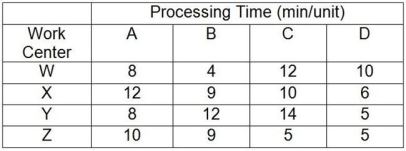Table 5.2
A company makes four products that have the following characteristics: Product A sells for $75 but needs $20 of materials and $20 of labor to produce; Product B sells for $90 but needs $45 of materials and $20 of labor to produce; Product C sells for $110 but needs $50 of materials and $30 of labor to produce; Product D sells for $135 but needs $75 of materials and $40 of labor to produce. The processing requirements for each product on each of the four machines are shown in the table.

Work centers W, X, Y, and Z are available for 40 hours per week and have no setup time when switching between products. Market demand is 50 As, 60 Bs, 70 Cs, and 80 Ds per week. In the questions that follow, the traditional method refers to maximizing the contribution margin per unit for each product, and the bottleneck method refers to maximizing the contribution margin per minute at the bottleneck for each product.
-Use the information in Table 5.2. Using the traditional method, what is the optimal product mix?
Definitions:
Total Assets
The total value of everything a company owns, encompassing cash, stocks, real estate, and machinery.
Common Stockholders
Investors who own shares of common stock in a company, granting them voting rights and a share in the company's profits through dividends.
Operating Expenses
Costs associated with the day-to-day operations of a business, excluding costs directly linked to the production of goods or services.
Gross Profit Rate
A profitability ratio that indicates how well net sales cover administrative and selling expenses.
Q23: Risk is a measure of the probability
Q24: Performance measures such as average response times,repair
Q26: Time-series analysis is a statistical approach that
Q31: A(n)_ is an operation that has the
Q45: Lean systems try to:<br>A)produce a product in
Q81: Use the information in Table 5.2.Using the
Q125: What are the primary responsibilities of a
Q130: A back office operation most closely resembles
Q149: Use the information provided in Table 8.3.If
Q239: More fixed automation typically means:<br>A)decreased labor productivity.<br>B)longer